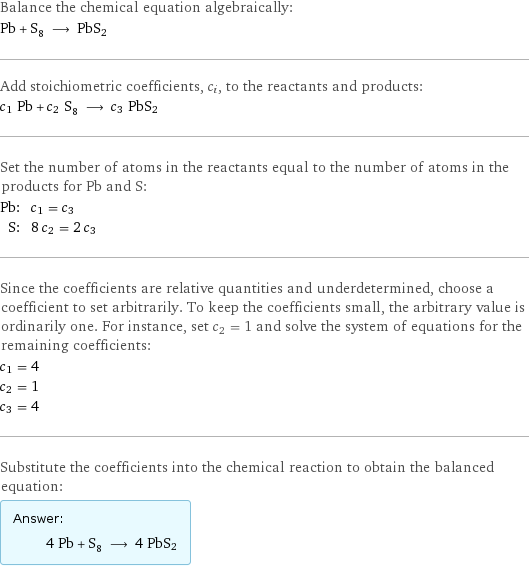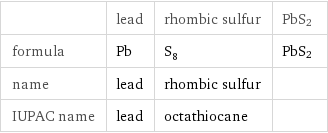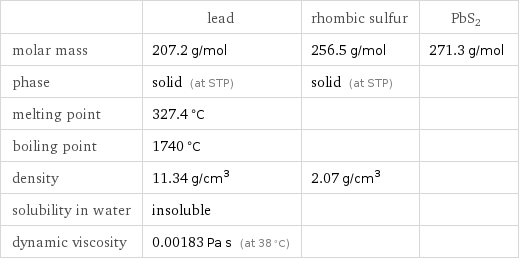Input interpretation

Pb (lead) + S_8 (rhombic sulfur) ⟶ PbS2
Balanced equation

Balance the chemical equation algebraically: Pb + S_8 ⟶ PbS2 Add stoichiometric coefficients, c_i, to the reactants and products: c_1 Pb + c_2 S_8 ⟶ c_3 PbS2 Set the number of atoms in the reactants equal to the number of atoms in the products for Pb and S: Pb: | c_1 = c_3 S: | 8 c_2 = 2 c_3 Since the coefficients are relative quantities and underdetermined, choose a coefficient to set arbitrarily. To keep the coefficients small, the arbitrary value is ordinarily one. For instance, set c_2 = 1 and solve the system of equations for the remaining coefficients: c_1 = 4 c_2 = 1 c_3 = 4 Substitute the coefficients into the chemical reaction to obtain the balanced equation: Answer: | | 4 Pb + S_8 ⟶ 4 PbS2
Structures

+ ⟶ PbS2
Names

lead + rhombic sulfur ⟶ PbS2
Equilibrium constant
![Construct the equilibrium constant, K, expression for: Pb + S_8 ⟶ PbS2 Plan: • Balance the chemical equation. • Determine the stoichiometric numbers. • Assemble the activity expression for each chemical species. • Use the activity expressions to build the equilibrium constant expression. Write the balanced chemical equation: 4 Pb + S_8 ⟶ 4 PbS2 Assign stoichiometric numbers, ν_i, using the stoichiometric coefficients, c_i, from the balanced chemical equation in the following manner: ν_i = -c_i for reactants and ν_i = c_i for products: chemical species | c_i | ν_i Pb | 4 | -4 S_8 | 1 | -1 PbS2 | 4 | 4 Assemble the activity expressions accounting for the state of matter and ν_i: chemical species | c_i | ν_i | activity expression Pb | 4 | -4 | ([Pb])^(-4) S_8 | 1 | -1 | ([S8])^(-1) PbS2 | 4 | 4 | ([PbS2])^4 The equilibrium constant symbol in the concentration basis is: K_c Mulitply the activity expressions to arrive at the K_c expression: Answer: | | K_c = ([Pb])^(-4) ([S8])^(-1) ([PbS2])^4 = ([PbS2])^4/(([Pb])^4 [S8])](../image_source/de9910c5a74007613f88d3c200ca579b.png)
Construct the equilibrium constant, K, expression for: Pb + S_8 ⟶ PbS2 Plan: • Balance the chemical equation. • Determine the stoichiometric numbers. • Assemble the activity expression for each chemical species. • Use the activity expressions to build the equilibrium constant expression. Write the balanced chemical equation: 4 Pb + S_8 ⟶ 4 PbS2 Assign stoichiometric numbers, ν_i, using the stoichiometric coefficients, c_i, from the balanced chemical equation in the following manner: ν_i = -c_i for reactants and ν_i = c_i for products: chemical species | c_i | ν_i Pb | 4 | -4 S_8 | 1 | -1 PbS2 | 4 | 4 Assemble the activity expressions accounting for the state of matter and ν_i: chemical species | c_i | ν_i | activity expression Pb | 4 | -4 | ([Pb])^(-4) S_8 | 1 | -1 | ([S8])^(-1) PbS2 | 4 | 4 | ([PbS2])^4 The equilibrium constant symbol in the concentration basis is: K_c Mulitply the activity expressions to arrive at the K_c expression: Answer: | | K_c = ([Pb])^(-4) ([S8])^(-1) ([PbS2])^4 = ([PbS2])^4/(([Pb])^4 [S8])
Rate of reaction
![Construct the rate of reaction expression for: Pb + S_8 ⟶ PbS2 Plan: • Balance the chemical equation. • Determine the stoichiometric numbers. • Assemble the rate term for each chemical species. • Write the rate of reaction expression. Write the balanced chemical equation: 4 Pb + S_8 ⟶ 4 PbS2 Assign stoichiometric numbers, ν_i, using the stoichiometric coefficients, c_i, from the balanced chemical equation in the following manner: ν_i = -c_i for reactants and ν_i = c_i for products: chemical species | c_i | ν_i Pb | 4 | -4 S_8 | 1 | -1 PbS2 | 4 | 4 The rate term for each chemical species, B_i, is 1/ν_i(Δ[B_i])/(Δt) where [B_i] is the amount concentration and t is time: chemical species | c_i | ν_i | rate term Pb | 4 | -4 | -1/4 (Δ[Pb])/(Δt) S_8 | 1 | -1 | -(Δ[S8])/(Δt) PbS2 | 4 | 4 | 1/4 (Δ[PbS2])/(Δt) (for infinitesimal rate of change, replace Δ with d) Set the rate terms equal to each other to arrive at the rate expression: Answer: | | rate = -1/4 (Δ[Pb])/(Δt) = -(Δ[S8])/(Δt) = 1/4 (Δ[PbS2])/(Δt) (assuming constant volume and no accumulation of intermediates or side products)](../image_source/3f3890b7483056806791bf520cb3087d.png)
Construct the rate of reaction expression for: Pb + S_8 ⟶ PbS2 Plan: • Balance the chemical equation. • Determine the stoichiometric numbers. • Assemble the rate term for each chemical species. • Write the rate of reaction expression. Write the balanced chemical equation: 4 Pb + S_8 ⟶ 4 PbS2 Assign stoichiometric numbers, ν_i, using the stoichiometric coefficients, c_i, from the balanced chemical equation in the following manner: ν_i = -c_i for reactants and ν_i = c_i for products: chemical species | c_i | ν_i Pb | 4 | -4 S_8 | 1 | -1 PbS2 | 4 | 4 The rate term for each chemical species, B_i, is 1/ν_i(Δ[B_i])/(Δt) where [B_i] is the amount concentration and t is time: chemical species | c_i | ν_i | rate term Pb | 4 | -4 | -1/4 (Δ[Pb])/(Δt) S_8 | 1 | -1 | -(Δ[S8])/(Δt) PbS2 | 4 | 4 | 1/4 (Δ[PbS2])/(Δt) (for infinitesimal rate of change, replace Δ with d) Set the rate terms equal to each other to arrive at the rate expression: Answer: | | rate = -1/4 (Δ[Pb])/(Δt) = -(Δ[S8])/(Δt) = 1/4 (Δ[PbS2])/(Δt) (assuming constant volume and no accumulation of intermediates or side products)
Chemical names and formulas

| lead | rhombic sulfur | PbS2 formula | Pb | S_8 | PbS2 name | lead | rhombic sulfur | IUPAC name | lead | octathiocane |
Substance properties

| lead | rhombic sulfur | PbS2 molar mass | 207.2 g/mol | 256.5 g/mol | 271.3 g/mol phase | solid (at STP) | solid (at STP) | melting point | 327.4 °C | | boiling point | 1740 °C | | density | 11.34 g/cm^3 | 2.07 g/cm^3 | solubility in water | insoluble | | dynamic viscosity | 0.00183 Pa s (at 38 °C) | |
Units
